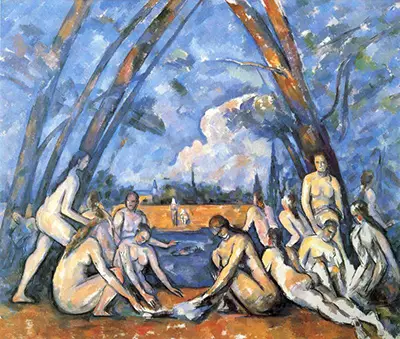Paul Cezanne created hundreds of paintings of nude figures from the 1870s onwards, culminating in three large scale pieces, one of which was The Large Bathers.
Cezanne worked on the painting of The Bathers for around seven years but it was still incomplete at the time of his death in 1906. The painting is also referred to as The Large Bathers and was completed as an oil on canvas. When it was exhibited shortly after his death, the painting received much praise from other artists. Matisse and Picasso had both viewed the painting and Picasso was particularly impressed with Cezanne's use of geometric shapes. In 1907, Picasso produced his own cubist painting of nude bathers, titled Les Demoiselles D'Avignon.
The painting depicts fourteen nude bathers near a body of water. They are arranged in two triangular shaped groupings. A cathedral-like arch, created by the trees, forms yet another triangular shape and provides an overall framework for both groups of bathers. A swimmer is just visible in the water and walking away from the water is a figure of a man and a horse. It has been suggested that the man is Cezanne himself. A village setting appears in the background of the painting. This is probably Aix, in Province but there are no clear or identifiable features to provide an exact location.
Cezanne did not use models for his nudes. He drew upon his imagination and prior studies instead. Some writers have noted similarities to various sculptures that Cezanne would have studied at the Louvre. The crouching figure on the right has a pose similar to a statue of a crouching Venus, the striding figure is similar to a statue of the Hunter Diane. The tall figure on the left of the painting is said to resemble the Venus de Milo statue. The scene itself has also been compared to some classical works, particularly Titian's but the style of the painting differs entirely.
The figures are flat, slightly elongated and not depicted as sensual objects. The choice of colours; the blues, greys and greens help to blend the already abstracted figures into the landscape. In some areas of the canvas no paint had ben applied at all. These areas show up as the white patches on the bathers' bodies. Six of the bathers do not face the viewer which creates a sense of detachment and gives the scene an air of mystery according to some writers. Some of the figures blend into the scenery or merge into each other. Some are depicted as if seen from multiple viewpoints. Cezanne has also used multiple lines on some of his bathers.
The painting was purchased for the Philadelphia Museum of Art in 1937 for the sum of 110,000 dollars. Cezanne may have painted numerous bathers and nudes in his lifetime but this painting is often viewed as his finest. Although it might not have been finished, The Bathers provided the art world with a new direction and in Picasso's words: "...Cezanne's influence gradually flooded everything..."




